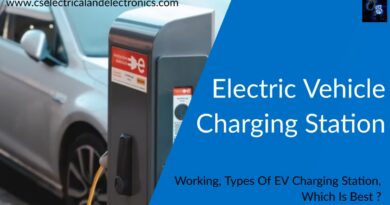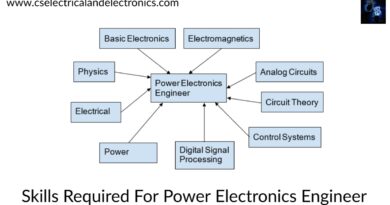Why ECU Is Used In Cars, Working Of Electronic Control Unit
Hello guys, welcome back to our blog. In this article, we will discuss why ECU is used in cars, what is ECU or electronic control unit, the working of the electronic control unit, advantages, and disadvantages.
If you have any electrical, electronics, and computer science doubts, then ask questions. You can also catch us on Instagram – CS Electrical & Electronics.
Also, read:
- Top 10 Programming Languages For IoT Engineers, Internet Of Things.
- Different Types Of Microcontrollers Used In Electric Vehicles, Electric Cars.
- Which Is the Best Microcontroller To Use, Microcontroller For Engineers.
Why ECU Is Used In Cars (Electronic Control Unit)
What is an ECU in a vehicle?
An electronic control unit (ECU), also known as an electronic control module (ECM) in automotive electronics, is an embedded system that regulates one or more electrical systems or subsystems of a vehicle.
Working of ECU (Electronic Control Unit):-
Depending on its role, an ECU gets data from various sections of the car. When a passenger presses the door lock/unlock button on a car door or a wireless key fob, for example, a door lock ECU receives input. Crash sensors and sensors that detect when someone is seated in a specific seat would provide input to an airbag ECU. In addition, forward-facing radars that detect when the vehicle is approaching an impediment too quickly would provide input to an automatic emergency braking ECU.
The ECU would then communicate with actuators, instructing them to take action in response to the inputs. The door lock ECU in our instances would trigger an actuator to lock or unlock the associated door. Depending on the location of the passengers, the airbag ECU would decide which airbags to deploy and then command the actuators to do so. To avoid a collision, the automated emergency braking ECU would apply the brakes.
The ECU is commonly referred to as the engine’s “brain.” In a relatively tiny case, it combines a computer, a switching system, and a power management system. It must incorporate four separate areas of activity to function even at a rudimentary level.
Input
This is how an ECU gathers the data it needs to make decisions, and it often includes temperature and pressure sensors, on/off signals, and data from other modules within the vehicle. A Coolant Temperature sensor or an Accelerator Pedal Position sensor are examples of inputs. Requests from the Antilock Brake System (ABS) module, such as traction control application, may also be considered.
Processing
The processor must determine output characteristics, such as fuel injector pulse width, as directed by the software stored within the unit once the data has been acquired by the ECU. Not only does the processor read the program to determine the necessary output, but it also keeps track of its own data, such as learning mixture changes and mileage.
Output
The ECU can then take action on the engine, providing the proper amount of power to accurately regulate actuators. Controlling the width of a fuel injector pulse, the precise timing of the ignition system, the opening of an electronic throttle body, or the activation of a radiator cooling fan are examples of these.
Power Management
For the hundreds of internal components to function properly, the ECU requires a lot of internal power. Furthermore, the ECU must supply the necessary voltage to components throughout the car for various sensors and actuators to function. For sensors, this might be as low as 5 volts or as high as 200 volts for fuel injector circuits. Not only must the voltage be corrected, but some outputs must also take more than 30 amps, which generates a significant amount of heat. Thermodynamic management is an important aspect of ECU design.
Types Of ECU Or Electronic Control Unit
Vehicles with several ECUs are classified based on the jobs they perform. The following are a few examples of these sorts.
01. Engine Control Module
The ECM uses sensors to guarantee that the engine receives the proper amount of fuel and ignition timing for maximum power and efficiency.
02. Brake Control Module
The BCM, which is found in vehicles equipped with anti-lock brakes, ensures that the wheels do not slide and determines when to apply the brakes and when to let go of the brake to prevent the wheels from locking up.
03. Transmission Control Module
The TCM, when used in an automatic vehicle, ensures that you get the smoothest shifts possible by analyzing the car’s engine RPM and acceleration.
04. Telematic Control Module
Another TCU, this one with the same abbreviation, verifies that the car’s onboard services are operational. It is in charge of the vehicle’s satellite navigation, as well as its Internet and phone communication.
05. Suspension Control Module
The SCM ensures the correct ride height and optimal suspension modifications depending on the driving circumstances in cars with active suspension systems.
Uses of ECU (Electronic Control Unit)
The electronic control unit (ECU) in today’s cars and trucks is responsible for controlling the activities of the engine and other components. An ECU is a computer similar to a home computer or laptop that has inbuilt pre-programmed and programmable computer chips. All engine functions are controlled by the vehicle’s engine computer ECU, which uses input sensors and output components to operate the engine.
Different ECUs are utilized for various systems on the car. ECUs can be utilized for transmission, traction control or ABS, air conditioning, body functions, lighting control, engine, airbags, or any other system in a vehicle. Some vehicles use a powertrain control module, which combines many ECUs into a single unit (PCM). These units can be advantageous since they house numerous modules in one area, but they can also be disadvantageous because they require longer lines to reach the component they control.
Advantages of ECU
- Power and torque should be increased.
- Boost Your Fuel Economy
- Enhance the performance and drivability of your vehicle.
- Throttle response has been improved.
- Customize it to your liking
Disadvantages of ECU
- Fuel use has increased.
- Insurance premiums for automobiles
- The car is put under more stress.
- Possibility of voiding the warranty
- It is not inexpensive.
To sum up, A control function is included in the majority of vehicle ECUs, particularly in the domains of powertrain, chassis, and body. Monitoring capabilities are included in control ECUs or can be added as standalone modules (e.g., in safety-related ECUs). In general, the control (of the controlled element) is based on a physical variable such as temperature, voltage, pressure, rotational speed, torque, and so on for the control type of ECUs.
I hope this article may help you all a lot. Thank you for reading.
Also, read the following:
- 100 + Electrical Engineering Projects For Students, Engineers
- 1000+ Electronics Projects For Engineers, Diploma, MTech Students
- 1000+ MATLAB Simulink Projects For MTech, Engineering Students
- 500+ Embedded System Projects For Engineer, Diploma, MTech, PhD
- 500+ Projects For Diploma Electrical, Electronics Student, Diploma Project
- 8051 Microcontroller Timers, TCON Register, TMOD Register
- Advancements In 3D Printing Technology And It’s Future
- Advancements In Power Electronics For Energy Efficiency
Author Profile
- Chetu
- Interest's ~ Engineering | Entrepreneurship | Politics | History | Travelling | Content Writing | Technology | Cooking
Latest entries
 All PostsApril 13, 2024What Is TCM, Transmission Control Module, Working, Purpose,
All PostsApril 13, 2024What Is TCM, Transmission Control Module, Working, Purpose, All PostsApril 12, 2024Top 100 HiL hardware in loop Interview Questions With Answers For Engineers
All PostsApril 12, 2024Top 100 HiL hardware in loop Interview Questions With Answers For Engineers All PostsMarch 22, 2024Driver Monitoring Systems In Vehicles, Working, Driver Sleepy Alert
All PostsMarch 22, 2024Driver Monitoring Systems In Vehicles, Working, Driver Sleepy Alert All PostsMarch 10, 2024Top 100 Automotive Interview Questions With Answers For Engineers
All PostsMarch 10, 2024Top 100 Automotive Interview Questions With Answers For Engineers








